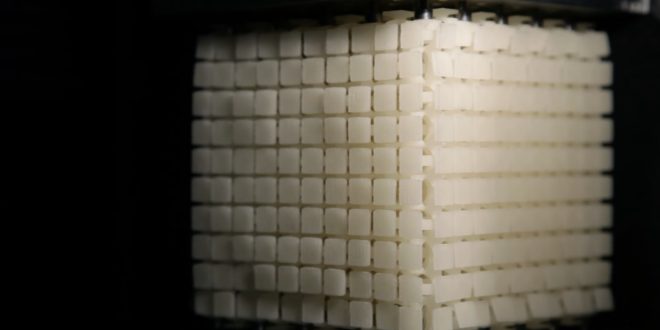Scientists have developed new “metamaterials” that can solve problems like ill-fitting joint sockets, contact dermatitis and sebaceous cysts plaguing prosthetic patients for a long time.
Scientists at Tel Aviv University, FOM Institute AMOLF and Leiden University in the Netherlands have developed a new approach to manufacturing mechanical “metamaterials” — synthetic composite materials with structures and properties not usually found in natural materials — that can be programmed to deform in a uniquely complex manner.
The breakthrough may have future applications in soft robotics and wearable technologies — and may lead to more close-fitting, comfortable and user-friendly prosthetics. The research was published this week in the journal Nature.
Putting a smile on a cube
Dr. Yair Shokef of TAU’s School of Mechanical Engineering and Prof. Martin van Hecke of Leiden University and AMOLF, the Netherlands, illustrated their approach through a three-dimensional printing of a metamaterial cube. A smiley-face pattern emerged on the side of the cube when it was compressed between custom-patterned surfaces.
“We started with a series of flexible building blocks, or bricks, that had deformation properties that varied with their position,” said Dr. Shokef. “The blocks were able to change their shape when we applied pressure. From there, we were able to develop a new design principle to enable these bricks to be oriented and assembled into a larger metamaterial with machine-like functionalities.”
The metamaterial has the unusual property that spatially-patterned compression in one direction leads to predictable spatially-patterned deformation (dents and protrusions) in other directions.
“A pattern of specific bulges appears when our seemingly normal cube is compressed,” said Dr. Shokef. “Using metamaterials, we can ‘program’ the material’s behavior by carefully designing its spatial structure.”
“For example, a pattern of holes in a sheet of material produces a mechanical response that is completely different than in the same material without holes,” said Prof. van Hecke. “We also wanted to investigate this phenomenon for a three-dimensional pattern of holes.”
One cube atop another
The researchers calculated the number of possible stacks for different cubes of building blocks. They then developed a cube of 10x10x10 centimeter blocks on which a smiley face appears when the cube is compressed. This demonstrated that any given pattern can be produced on a cube’s surface.
“For each possible stack, the deformation within the cube results in a specific pattern on the sides of the cube,” said Dr. Shokef. “We can carefully combine the building blocks in a way that any desired pattern can appear on the sides of a compressed cube. We can also use the cube to analyze these patterns.”
There are many applications on the horizon for this new basic research. “This type of programmable ‘machine material’ could be ideal for prostheses or wearable technology in which a close fit with the body is important,” Dr. Shokef said. “If we can make the building blocks even more complex or produce these from other materials, the possibilities really are endless.”
Agencies/Canadajournal

 Canada Journal – News of the World Articles and videos to bring you the biggest Canadian news stories from across the country every day
Canada Journal – News of the World Articles and videos to bring you the biggest Canadian news stories from across the country every day

